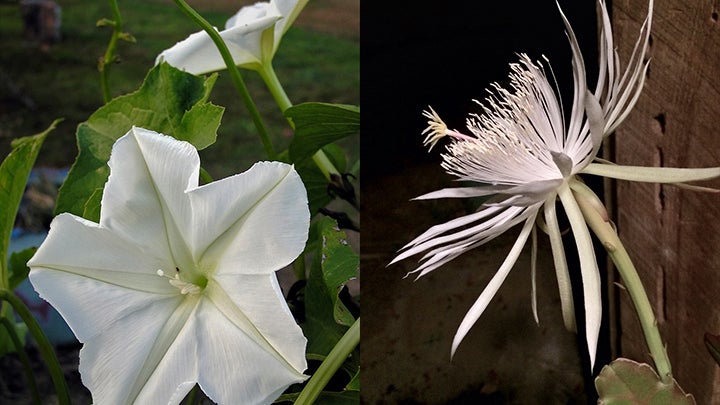Of the sun and moon
Published 3:00 pm Sunday, June 12, 2022

- Photos by Felder Rushing / From left, Moonflower and Cereus
Summer solstice, the shortest night of the year, is upon us, reminding us tof the waxing and waning of daylight. Not as superstition-filled as winter solstice, but still a good time to relax in a well-planned evening garden and reflect on Life.
Not all that long ago, B.T. (before television) most folks spent their early evenings outside after a long day’s work and get away from the kitchen heat. My parents were the first generation to have air conditioning; before that we could only hope the screen windows would keep most of the ‘skeeters out, but they did nothing to alleviate the suffocating humidity.
So, to catch evening breezes we crowded around on porch swings and rockers, or in lawn chairs, like some of my neighbors still do, cut off the porch lights to keep from attracting buzzing insects, let eyes gradually adjust and get used to the gathering dark, the better to listen to frog songs and see the lightening bugs, and huge hawk moths that hover around evening flowers. This was the last generation that truly appreciated four o’clock flowers with their heady evening fragrance and sat on the porch waiting for the heirloom night blooming cereus cactus to come into full fragrant bloom.
My grandmother even had a “moon garden” filled with light colored and fragrant flowers, whose perfumes hung in the heady air much more noticeably than during the day. Some of her favorites for fragrance were a bucketful of old-fashioned reseeding petunias, jasmine, ligustrum, mimosa, old roses, gardenia, magnolia, and honeysuckle.
Most of these flowers glowed in the cool white moonlight, in an attempt to attract pollinators. Nothing beats the moonflower vine with its huge white flares, though evening pollinators also flocked to cleome, sacred moon flower (Datura, also called Devil’s trumpet), angel trumpet, nicotiana, periwinkle, crinum and other lilies, and the afore-mentioned gardenias and magnolia, plus plants with light colored foliage such as sage, dusty miller, and ghostly gray artemisia.
Night-shimmery garden accessories also accented this scene. Think silver gazing ball, a bottle tree made of just clear bottles, a reflecting pool or bird bath, all reflective to further enhance the twilight scene. Though I usually ease back on the water pressure in my splashy fountain to reduce summer evaporation, this is the time of year when I crank it back up to create “white noise” that turns urban sounds into muted background. This is some serious relaxation.
And forget night lighting this time of year, with the extended twilight keeping us on the path till way past time to go in for the evening. In fact, sure night footing can be provided with just a few scattered light-colored flagstone or pale stepping stones, leading to a white bench or arbor. Lining the path with pale variegated Liriope is a good guide in the waning light.
In fact, a moon garden – more than just a sensuous collection of fragrant plants and those with pretty flowers that glow in the light of the moon – is all about relaxation. Hectic lives and weary minds need a place to spend a few moments for rest, catch breaths, and settle down, if even just for a few minutes before the ‘skeeters find us. And to get away from the television with its nonstop bad news.
With the coming of the summer solstice, evenings are gradually getting shorter. Need to grab as much time in the pale moonlight as we can. Time to turn off the tv and porch light, and chill outside with family or friends and wait for the moonflower and cereus to open.
Felder Rushing is a Mississippi author, columnist, and host of the Gestalt Gardener on MPB Think Radio. Email gardening questions to rushingfelder@yahoo.com.





